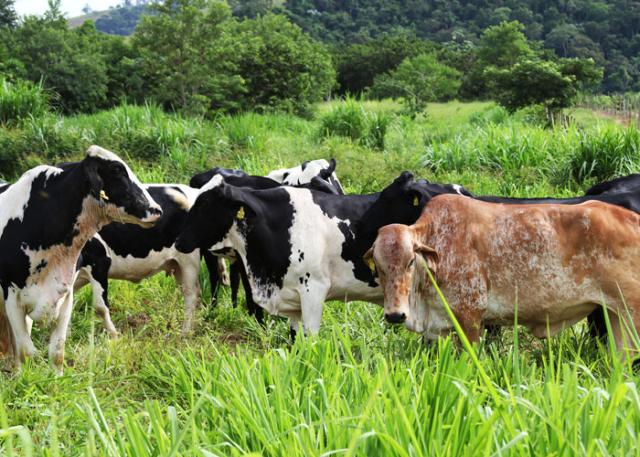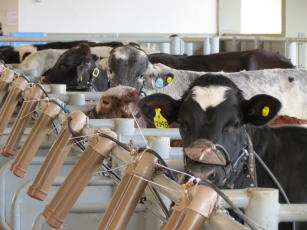Well-managed dairy farms' greenhouse gas sequestration exceeds their emissions
Well-managed dairy farms' greenhouse gas sequestration exceeds their emissions
Photo: Rubens Neiva

Studies suggest that GHG emissions reported by IPCC do not correspond to Brazilian reality.
The carbon balance in Brazilian milk production systems can be positive, assert the researchers affiliated with the Pecus Project – RumenGases, coordinated by Embrapa. Research has revealed that by adopting sustainable practices in herd management and pasture management, greenhouse gas (GHG) emissions are lower than the carbon that is 'sequestered' by the activity. According to the researchers, that is due to how Brazilian herds feed, a system that is primarily based on pastures.
"In a well-managed farm, the carbon amounts emitted into the atmosphere as methane by cows is mitigated by the carbon that pastures and other plant crops can absorve", asserts the Embrapa Dairy Cattle researcher Luiz Gustavo Pereira, who is part of the Project. According to the researcher, this information contributes to desmystifying the role of cattle farming as a villain in the rise in global temperatures. "Depending on how it is conducted, livestock production can be seen as a provider of an important environmental service for the planet", Pereira assesses.
The studies also suggest that the methodologies to estimate GHG emissions recommended by the UN's Intergovernmental Panel on Climate Change (IPCC) do not fully correspond to national conditions. In some cases, the methodology used by the Panel overestimates GHG emissions from cattle farming. That occurs because the Panel's figures are absolute and disregard the characteristics of each country. The very own IPCC suggests the elaboration of regional studies on the issue.
To grant higher precision to the indicators, the researchers who take part in the Pecus – RumenGases Project measured GHG emissions in dairy farms of the state of Minas Gerais. The results obtained indicate that the IPCC methodology is only suitable for two categories of cattle in Brazil: low-producing cows and heifers weighing 350 kg to 400 kg. In the case of heifers weighing up to 200 kg and average to high-production cows, the Panel's indicators are above the emissions that actually occur in the country's dairy farms.
The researchers involved in the Project are organizing a database with information from all over the country with regard to methane (CH4) emissions from dairy farming. The goal is to generate a national model to measure GHG emissions and outline mitigation strategies. The work is coordinated by a team from the Laboratory on Livestock Metabolism and Environmental Impacts, an international reference center in the assessment of enteric methane. The Lab is part of the Multiuser Complex for Bioefficiency and Livestock Sustainability at Embrapa Dairy Cattle and is located in Coronel Pacheco, MG.
Primary sector and GHG emissions
Scientific studies related to global warming demonstrate that bovines, when observed in isolation, indeed have a relevant role in GHG emissions. Pereira explains that the process of ruminant nutrition produces methane, which is mainly released through eructation (animal burping). "Ruminant digestion includes fermentation to utilize cellulose as food. The process produces CH4, whose potential to cause global warming is 25 times higher than carbon dioxide," the researcher explains.
According to IPCC, the agricultural sector is responsible for 13.5% of annual emissions of CO2eq (carbon dioxide equivalent, an indicator that proportionally compares all greenhouse gases to carbon dioxide emissions). For the non-governmental organization Greenpeace, when added to emissions from deforestation and the indiscriminate use of fertilizers, GHG emissions from the sector near 32% of all emissions from humankind. Among all agricultural activities, livestock production is one of the largest emitters of CO2eq. The good news is that the trend can be reversed.
Sustainable practices
With sustainable practices, cattle-farming ceases to be a carbon emitter to become a source of GHG reduction. The measures recommended by Embrapa for that purpose are as follows:
- Recover and adequately manage pastures: It is estimated that there are 180 million hectares of pastures in Brazil, more than half of which have some level of degradation. Well-managed pastures bring two benefits: the first one is that, from a nutritional standpoint, pasture is cheap feed for the herd and its quality determines a lower use of grains in their diet. As for the second benefit, from an environmental standpoint, good pastures accumulate more organic matter in the soil, sequestering carbon.
- Integrated Crop-Livestock-Forestry Systems (ICLFS): Adopting ICLFS is a solution for the problem of low pasture quality. Strengthening a Low Carbon Agriculture centers on livestock through pasture recovery and ICLFS. In integrated production systems, farming animals in tropical conditions has great capacity for carbon sequestration. The ICLF systems can expand national agricultural production without the need to clear new frontiers, which is positive in terms of GHG emissions.
- Quality feed for the herd: It is a direct consequence of improved pastures. A nutritional strategy for GHG mitigation is providing cattle with adequate nourishment. It reduces CH4 production in the rumen and promotes a general improvement to animal performance indicators and a higher lactation rate, consequently emitting less methane per kg of milk.
- Animal genetic improvement: This is one of the areas which have evolved the most in the last few years. In dairy farming, an example is dairy Gyr, a breed that is adapted to Brazilian conditions. The cows' average production in progeny tests in 1985 was 1,900kg/lactation; nowadays, it has reached 4,390 kg/lactation. Increased bovine productivity is a GHG mitigation strategy.
The GHG emission indicators for livestock can vary a lot from one country to another or from one production system to another. Dairy farming in Brazil, which explores pastures, is different from the activity in Canada, which adopts confinement systems, for instance. That justifies an in-depth study on national cattle farming with regard to the issue. According to the Embrapa Agricultural Informatics researcher Eduardo Delgado Assad, the average CO2eq emission per bovine is 57 kg/animal/year. But that figure represents only what the animal releases. "When we place the bovine in a pasture and consider the whole, things change," Assad says.
Considering a system with a stocking rate of one AU/ha (Animal Unit/hectare) in a degraded pasture, the bovine releases around 1,800 kg of CO2eq. A second system with the same animal in a good, well-managed pasture, can have the pasture sequester 3,600 kg of CO2eq per year. Thus there is a positive surplus of 1,800 kg of CO2eq removed from the atmosphere. Assad's conclusion, which is backed by the Pecus Project studies, is: "In a well-managed cow/pasture system, there are no greenhouse gas emissions, there are removals."
Pecus Project
Comprising 12 projects, Pecus assesses GHG dynamics and the carbon balance in agricultural production systems in six Brazilian biomes (Atlantic Rainforest, Caatinga, Pantanal, Pampa, Amazon Rainforest and Cerrado). One of the components of Pecus is RumenGases, which includes research on ruminant enteric emissions.
RumenGases is divided in two parts: "conceptual advances", which standardize and validate methodologies used for the assessment of enteric methane emissions from dairy and beef cattle, sheep, goats and buffaloes, and "mitigation strategies", which investigate the results of pasture management, integrated crop-livestock systems, beef cattle confinement, silvopastoral systems, and diet ingredients in GHG mitigation.
The Project involves dozens of national and international partners, including research institutes, government agencies, universities, and the milk industry.
Translation: Mariana de Lima Medeiros
Rubens Neiva (MTb 5445)
Embrapa Dairy Cattle
Press inquiries
rubens.neiva@embrapa.br
Phone number: (32) 3311-7532
Further information on the topic
Citizen Attention Service (SAC)
www.embrapa.br/contact-us/sac/

